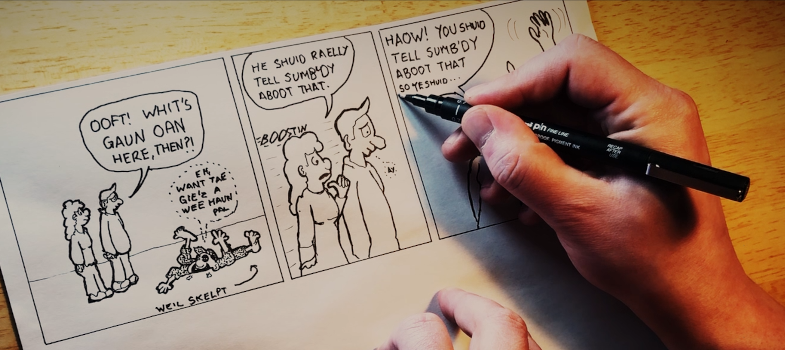Model Plan Unit 3.4 Activity 4
This is a sample lesson plan which you can compare with your own.
Focussing on Scots vocabulary for animals, and culminating with a lesson using the song, ‘Three Craws’, this Early Years lesson focuses mainly on developing children’s listening and talking skills. By the end of this lesson, children should be able to demonstrate that they can:
recognise patterns and rhyme;
listen for information and use it to learn new things; ask questions based on what they have listened to.
Note that the Experiences and Outcomes listed below are simply ‘touched on’ in this one lesson, as part of your larger topic or term with your learners.
Lesson Plan for Scots Language using ‘Coulter’s Candy’, ‘Morag’s Croft’ and ‘Three Craws’ with learners at CfE Early level
LITERACY: Listening and Talking
Lesson starter: Establish prior learning of Scots, using a listening activity - play the song ‘Coulter’s Candy’ and ask the children if any of the words are unusual. Make sure all of the children know what the word greetin means and explain that it is Scots. Explain that Scots is one of the languages spoken in Scotland. Show a map of Scotland.
With the whole group, play one level of ‘Pop the Balloons’ on the whiteboard. The children should match the Scots words to their English equivalents, using their prior learning or process of elimination.
Individually or in pairs, children play the ‘Morag’s Croft’ game and follow the instructions. They should match the animals with the Scots words, demonstrating that they can work out the meaning of the words: bubblyjock; dug; tod; coo; grumphie; hoolet; hurcheon; moose; brock; sparra; puddock; and maukin. This activity will demonstrate that they can listen for information.
Led by me, the whole group will watch the ‘Three Craws’ video and listen to the song. By pointing to pictures on the board (stills from the video), they will demonstrate their understanding of the following words: craw; waw; cauld; flee; greetin; skint.
To help the children demonstrate their understanding of the meaning of the song, the following questions will be asked:
What happens to each craw? What would they do afterwards?
To demonstrate that they can give a personal response, they will be asked: How does the song make us feel?
To demonstrate that they understand rhyme, they will be asked: Which words in the song rhyme with ‘craw’?
LIT 0-01a, 0-11a, 0-2a, 0-01c, 0-04a, 0-07a
NUMERACY
To demonstrate that they are developing understanding about the number of objects in a
group and sequencing, the children will be asked:
How many craws are there?
(After each craw falls) How many craws are left after the craw falls?
MNU 0-01a, 0-03a,
Expressive Arts: Dance
To demonstrate that they can perform a range of gestures, the children will be asked to: Hold up the correct number of fingers for each craw;
Put your thumbs together and wiggle fingers for ‘flee’; Rub your eyes for ‘greetin’;
Hold the side of you face for ‘jaw’;
Hold your hands out, palms upwards for ‘wisnae there at aw’; Hug your arms and rub them for ‘cauld and frosty mornin’.
EXA 0-08a
Expressive Arts: Music
To demonstrate that they can participate actively and enjoy rhythm, the children will be asked to:
Learn the song and sing along;
Tell the group if they you like the song, and why?
EXA 0-16a, 0-17a
Return to Unit 3
